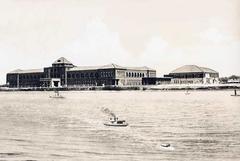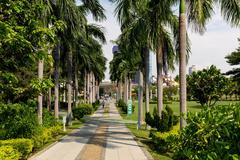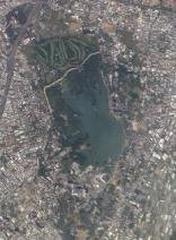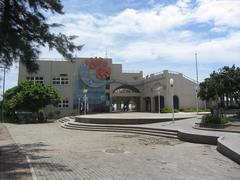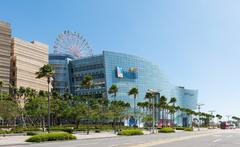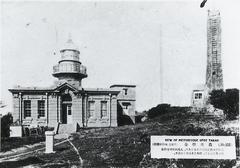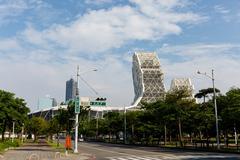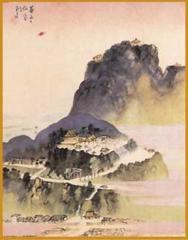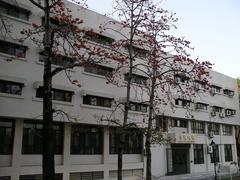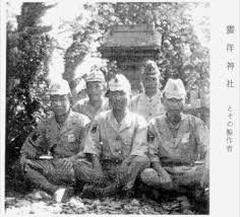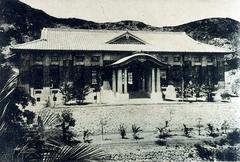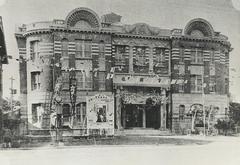Comprehensive Guide to Visiting Wufu Second Road, Kaohsiung, Taiwan
Date: 18/07/2024
Introduction
Wufu 2nd Road (五福二路) in Kaohsiung, Taiwan, is more than just a thoroughfare; it is a vibrant tapestry of history, culture, and modernity. This iconic road offers a unique glimpse into the city’s past, present, and future, making it a must-visit destination for anyone exploring Kaohsiung. From its historical roots during the Japanese colonial period to its current status as a bustling commercial and cultural hub, Wufu 2nd Road encapsulates the dynamic spirit of Kaohsiung. Visitors can enjoy a blend of traditional and contemporary experiences, including historical landmarks, modern shopping complexes, and cultural institutions. This comprehensive guide aims to delve into the road’s historical significance, economic impact, cultural evolution, and provide essential visitor information to ensure a memorable experience (Kaohsiung Museum of History, Kaohsiung LRT).
Table of Contents
- [Historical Background](#historical-backgroundhistorical-background)
- [Early Development and Urbanization](#early-development-and-urbanizationearly-development-and-urbanization)
- [Economic Significance](#economic-significanceeconomic-significance)
- [Cultural and Social Evolution](#cultural-and-social-evolutioncultural-and-social-evolution)
- [Modern Developments and Urban Renewal](#modern-developments-and-urban-renewalmodern-developments-and-urban-renewal)
- [Visitor Information](#visitor-informationvisitor-information)
- [Visiting Hours](#visiting-hoursvisiting-hours)
- [Ticket Prices](#ticket-pricesticket-prices)
- [Travel Tips](#travel-tipstravel-tips)
- [Nearby Attractions](#nearby-attractionsnearby-attractions)
- [Kaohsiung Museum of History](#kaohsiung-museum-of-historykaohsiung-museum-of-history)
- [Liuhe Night Market](#liuhe-night-marketliuhe-night-market)
- [Love River](#love-riverlove-river)
- [Conclusion](#conclusionconclusion)
- [FAQ](#faqfaq)
Historical Background
Early Development and Urbanization
Wufu 2nd Road is a significant thoroughfare in Kaohsiung, Taiwan, reflecting the city’s broader urban development. Originally a small fishing village known as Takao, Kaohsiung began to transform significantly during the Japanese colonial period (1895-1945). The Japanese administration initiated extensive urban planning and infrastructure projects, laying the groundwork for modern Kaohsiung. Wufu 2nd Road became a crucial part of the city’s transportation network, facilitating movement and commerce. The Japanese influence is still evident in some of the architectural styles and urban layouts found along Wufu 2nd Road. The road’s development continued post-World War II, as Taiwan underwent rapid industrialization and urbanization, further cementing its importance in Kaohsiung’s urban fabric.
Economic Significance
Wufu 2nd Road has historically been a commercial hub, contributing significantly to Kaohsiung’s economy. During the 1960s and 1970s, Taiwan experienced an economic boom, often referred to as the “Taiwan Miracle.” Kaohsiung, being one of the major port cities, played a pivotal role in this economic transformation. Wufu 2nd Road, with its strategic location, became a bustling center for trade and commerce. The road is lined with various businesses, ranging from traditional markets to modern shopping complexes. This blend of old and new reflects the economic evolution of the area. The presence of numerous banks, corporate offices, and retail outlets along Wufu 2nd Road underscores its continued economic importance.
Cultural and Social Evolution
Wufu 2nd Road is not just an economic artery but also a cultural and social landmark. The road has witnessed significant cultural shifts over the decades. During the Japanese colonial period, the introduction of Japanese culture and architecture left a lasting impact. Post-1945, with the retreat of the Kuomintang (KMT) to Taiwan, there was an influx of mainland Chinese culture, further diversifying the cultural landscape. The road is home to several cultural landmarks, including temples, theaters, and museums. These institutions serve as custodians of the area’s rich cultural heritage. For instance, the nearby Kaohsiung Museum of History offers insights into the city’s past, including the development of Wufu 2nd Road (Kaohsiung Museum of History).
Modern Developments and Urban Renewal
In recent years, Wufu 2nd Road has undergone significant modernization and urban renewal projects. The Kaohsiung City Government has invested in infrastructure improvements, including road widening, the installation of modern traffic management systems, and the beautification of public spaces. These efforts aim to enhance the quality of life for residents and make the area more attractive to tourists. One notable project is the Kaohsiung Light Rail Transit (LRT) system, which includes stops along Wufu 2nd Road. This modern transportation system has improved accessibility and reduced traffic congestion, making it easier for both locals and tourists to navigate the area (Kaohsiung LRT).
Visitor Information
Visiting Hours
Wufu 2nd Road is accessible 24/7, but individual businesses along the road have their own operating hours.
Ticket Prices
There is no fee to access Wufu 2nd Road itself, but some attractions like museums may have admission fees.
Travel Tips
- Special Events: Keep an eye out for local festivals and parades that often take place along the road.
- Guided Tours: Available through various local tour operators, offering deeper insights into the history and culture of Wufu 2nd Road.
- Photographic Spots: Don’t miss the architectural landmarks like Kaohsiung City Hall and the Grand Hi-Lai Hotel for great photo opportunities.
- Best Time to Visit: Early mornings and evenings are the best times to experience the road’s vibrant atmosphere without the midday heat.
Nearby Attractions
Kaohsiung Museum of History
Offers a comprehensive look at the city’s past, including the development of Wufu 2nd Road (Kaohsiung Museum of History).
Liuhe Night Market
A bustling market known for its street food, including local delicacies such as stinky tofu, oyster omelets, and papaya milk. The market operates from 6 PM to midnight, making it an ideal spot for evening exploration (Liuhe Night Market).
Love River
Perfect for a relaxing stroll or a boat ride. The riverbanks are lined with walking and cycling paths, making it a popular spot for both locals and tourists. Boat tours are available, offering a unique perspective of the city (Love River).
Conclusion
Wufu 2nd Road stands as a multifaceted landmark in Kaohsiung, embodying the city’s rich history, vibrant culture, and economic vitality. From its early development during the Japanese colonial period to its modern-day significance as a commercial and cultural hub, the road has continuously evolved, reflecting the dynamic changes in Kaohsiung. Visitors can enjoy a variety of attractions, including the historical Kaohsiung Museum of History, the bustling Liuhe Night Market, and the scenic Love River. The road’s accessibility through modern transportation systems like the Kaohsiung LRT further enhances its appeal, making it easy for both locals and tourists to explore. Whether you’re a history buff, a foodie, or a culture enthusiast, Wufu 2nd Road offers something for everyone, promising an enriching and enjoyable experience.
FAQ
What are the best times to visit Wufu 2nd Road?
Early mornings and evenings.
Is there an admission fee?
No, but some attractions may have entry fees.
Are there guided tours available?
Yes, through local tour operators.
References
- Kaohsiung Museum of History, 2024, Kaohsiung City Government https://khm.gov.tw/
- Kaohsiung Light Rail Transit (LRT), 2024, Kaohsiung Rapid Transit Corporation https://www.krtco.com.tw/en/
- Liuhe Night Market, 2024, Travel King https://www.travelking.com.tw/eng/tourguide/kaohsiung/liuhe-night-market.html
- Kaohsiung City Government, 2024, https://www.kcg.gov.tw/
- Kaohsiung Tourism, 2024, https://khh.travel/
- Pier-2 Art Center, 2024, Kaohsiung City Government https://pier-2.khcc.gov.tw/
